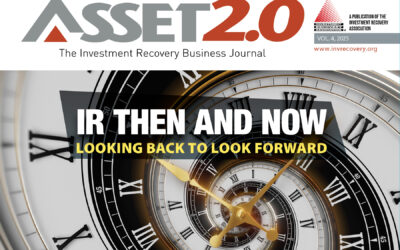
Practical AI for Investment Recovery: 12 Moves You Can Use Today (Highlights from the IRA AI Workshop)
At the Investment Recovery Association’s AI Workshop, keynote speaker Chuck Gallagher didn’t just talk about AI – he showed how to put it to work on problems IR teams face every week: sourcing niche suppliers, writing buyer-ready listings, translating video for international buyers, even drafting job descriptions that actually attract Gen Z applicants. The session wrapped with a sneak peek of the new IRA Assistant—our AI chatbot trained on IRA’s own body of knowledge. Here are the most useful takeaways, translated into immediate actions for investment recovery pros.
1) Trustworthy answers > fast answers
Large models can “hallucinate.” When stakes are real (contracts, compliance, safety), use tools that show their sources and pay for the pro tier when it matters. Chuck demonstrated Perplexity’s cited results and contrasted free vs. paid accuracy—worth it when you’re making buying/selling decisions.
Try this: When you research unfamiliar materials or processes, start in a cited search tool. Scan the source list before you act. If it’s mission-critical, cross-check once in a second model.
2) Multilingual video = bigger buyer pools
A simple iPhone clip was auto-dubbed into Mandarin and Spanish with synced lips and cloned voice—good enough that native speakers in the audience understood every word. That means your disposal notices, asset walk-throughs, and safety disclaimers can meet buyers where they are—without hiring a studio.
Try this: Record one 30–60s “condition overview” per high-value lot. Auto-translate it into your top two buyer languages and embed those versions on your listing page.
3) From “needle-in-a-haystack” to a vendor short-list
The room tossed out a tough one: find legitimate suppliers of fuming sulfuric acid (with contacts), plus import compliance pointers and a first-reach email draft. In minutes, the workflow produced a supplier list, compliance steps, and an editable outreach template—with sources to verify.
Template opener you can adapt:
“We’re a U.S.-based buyer seeking [spec/grade] fuming sulfuric acid. Please confirm current stock, spec sheet, export capability, Incoterms, and lead times.”
4) Make technical math painless
Need weights, volumes, or yields to quote freight or scrap? The session showed how to speak a natural query (“ten-inch diameter, 30-ft steel pipe—what’s the weight?”) and get the formula and the answer—fast. Use the math, then document the assumption (material, wall, density) in your lot file.
5) Turn one idea into two channels (SEO + video)
Chuck modeled a quick pattern: research with citations → ask for a web article and a YouTube monologue → publish both. He then asked for a narrative rewrite (less listicle, more story) tailored to the Investment Recovery audience—great reminder to request style changes, not just content.
Try this: For your next specialty asset (e.g., “second-life solar panels”), publish:
-
A narrative blog (“How to validate, market, and price panels with life left”)
-
A short video walkthrough reading the auto-generated monologue
Both feed discoverability and buyer trust.
6) “Custom instructions” = your on-call playbook
You can train your AI workspace to always: include compliance notes, add buyer keywords, output 3–5 listing variants (technical/financial/general), and attach a short H1 headline. Chuck showed how personal instructions make responses consistent and on-brand.
Snippet to paste into your AI settings:
-
“When I provide an asset (type, specs, age, photos, condition), write 3 listings for technical, financial, and general buyers, each with: short headline, bullet features, condition notes, and buyer-next-steps. Include relevant IR keywords.”
7) Hiring help that actually lands applicants
A live exercise turned a generic “cable chop operator” post into a Gen-Z-friendly description (safety-led, team wins, growth path). If you’re hiring for yards, processing, or warehousing, generate two versions: one “classic,” one “Gen Z.” Then invite the model to convert a candidate’s resume to the JD’s language to pass ATS screens.
8) Quick hits from audience scenarios
-
Right-size IR staffing: a starting model outlined roles (disposition, compliance, data) and headcount ranges for large utilities—useful for budget conversations.
-
End-of-life costs in procurement: draft negotiation prompts to surface OEM responsibilities and TCO at the front of the deal.
-
Wind-turbine blades: survey disposal and repurpose options (grinding, cement co-processing, reuse) and identify who handles it in the U.S.
-
Trucking to tough geographies (yes, even Smackover, AR): assemble carriers and explore AI-driven load-matching networks to lower backhaul costs.
9) Pick the right model for the job
-
Perplexity for cited research and supplier discovery
-
ChatGPT-5 for deeper research; 4 for stronger writing
-
Gemini for improving; Claude shines at long-form drafting
Don’t be precious—switch tools to get the answer you need.
10) Ethics still matter (especially with AI media)
Chuck demoed voice cloning—and emphasized permission and attribution. Even cool tech needs consent, credits, and guardrails. Build those checks into your team’s SOPs for marketing and training media.
11) Meet the IRA Assistant (Beta)
What it is: An AI chatbot trained on the IRA website, Asset 2.0 articles, associate member directory, Learning Center content, 360+ pages of the IRA Handbook, and transcribed videos—curated and kept in a walled garden to cut down on hallucinations. It answers with references so you can click back to the source. Keep your directory profile updated—that improves everyone’s results. Look for the chat icon on the site and send feedback as we keep training it.
(P.S. You’ll get to help name it—finalists included IVAN, IVA, VIA, and simply “IRA.”)
12) Your 30-day AI playbook for IR teams
- Add “cited search first” to every unusual material/process question.
- Record one 60s lot video; auto-translate into two buyer languages; post all versions.
- Create a custom instructions profile for listings (3 buyer variants, headline, condition notes, keywords).
- Standardize a supplier outreach email template; personalize per RFQ.
- Build a micro-SOP: “When math shows up, ask AI for formula + answer; paste assumptions into the file.”
- Publish one narrative blog + one YouTube monologue per month targeting high-value categories.
- Rewrite one open role for Gen-Z clarity; refresh the JD visuals and safety language.
- Prep three OEM-EPR negotiation prompts for your next capital buy.
- Spin up a “hard-to-reach lanes” carrier list and trial an AI load-matching network.
- Add an ethics checklist to media creation (permissions, disclosures, watermarking).
Bottom line: AI won’t do your job for you – but it will amplify what you already do well: find better buyers faster, present assets more clearly, and close responsibly. Start with cited research, publish in multiple formats/languages, and lean on the IRA Assistant for IRA-specific answers – and keep feeding it better data. That’s how we raise the floor for the whole community.


